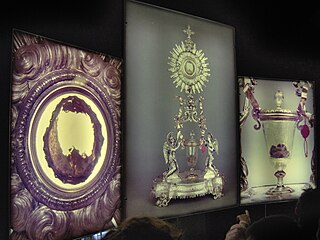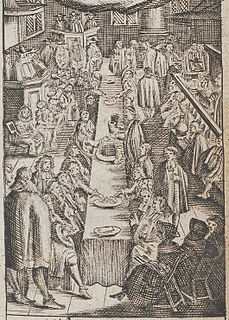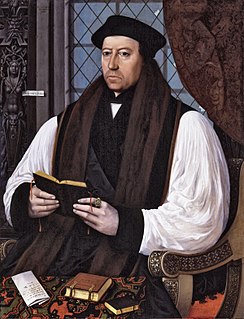
Berengar of Tours was an 11th-century French Christian theologian and Archdeacon of Angers, a scholar whose leadership of the cathedral school at Chartres set an example of intellectual inquiry through the revived tools of dialectic that was soon followed at cathedral schools of Laon and Paris. He came into conflict with Church authorities over the doctrine of transubstantiation of the Eucharist.

The Thirty-nine Articles of Religion are the historically defining statements of doctrines and practices of the Church of England with respect to the controversies of the English Reformation. The Thirty-nine Articles form part of the Book of Common Prayer used by both the Church of England and the Episcopal Church. Several versions are available online.

Peter Martyr Vermigli was an Italian-born Reformed theologian. His early work as a reformer in Catholic Italy and his decision to flee for Protestant northern Europe influenced many other Italians to convert and flee as well. In England, he influenced the Edwardian Reformation, including the Eucharistic service of the 1552 Book of Common Prayer. He was considered an authority on the Eucharist among the Reformed churches, and engaged in controversies on the subject by writing treatises. Vermigli's Loci Communes, a compilation of excerpts from his biblical commentaries organized by the topics of systematic theology, became a standard Reformed theological textbook.
Ratramnus a Frankish monk of the monastery of Corbie, near Amiens in northern France, was a Carolingian theologian known best for his writings on the Eucharist and predestination. His Eucharistic treatise, De corpore et sanguine Domini, was a counterpoint to his abbot Paschasius Radbertus’s realist Eucharistic theology. Ratramnus was also known for his defense of the monk Gottschalk, whose theology of double predestination was the center of much controversy in 9th-century France and Germany. In his own time, Ratramnus was perhaps best known for his Against the Objections of the Greeks who Slandered the Roman Church, a response to the Photian schism and defense of the filioque addition to the Niceno-Constantinopolitan Creed.

The real presence of Christ in the Eucharist is a term used in Christian theology to express the doctrine that Jesus is really or substantially present in the Eucharist, not merely symbolically or metaphorically.

A monstrance, also known as an ostensorium, is the vessel used in Roman Catholic, Old Catholic and Anglican churches for the more convenient exhibition of some object of piety, such as the consecrated Eucharistic host during Eucharistic adoration or Benediction of the Blessed Sacrament. It is also used as reliquary for the public display of relics of some saints. The word monstrance comes from the Latin word monstrare, while the word ostensorium came from the Latin word ostendere. Both terms, meaning "to show", are used for vessels intended for the exposition of the Blessed Sacrament, but ostensorium has only this meaning.

In Christian theology, the term Body of Christ has two main but separate meanings: it may refer to Jesus' words over the bread at the Last Supper that "This is my body" in Luke 22:19–20, or to the usage of the term by the Apostle Paul in 1 Corinthians 12:12–14 and Ephesians 4:1–16 to refer to the Christian Church. It may also refer to Christ's post-resurrection body in Heaven. Christ also associated himself with the poor of the world and this is also called the Body of Christ.“If we truly wish to encounter Christ, we have to touch his body in the suffering bodies of the poor, as a response to the sacramental communion bestowed in the Eucharist. The Body of Christ, broken in the sacred liturgy, can be seen, through charity and sharing, in the faces and persons of the most vulnerable of our brothers and sisters.” said Pope Francis on launching the World Day of the Poor.

In Christianity, a Eucharistic miracle is any miracle involving the Eucharist. In the Roman Catholic, Lutheran, Eastern Orthodox, Methodist, Anglican and Oriental Orthodox Churches, the fact that Christ is really made manifest in the Eucharist is correctly deemed a Eucharistic miracle; however, this is to be distinguished from other manifestations of God. In general, reported Eucharistic miracles usually consist of unexplainable phenomena such as consecrated Hosts visibly transforming into myocardium tissue, being preserved for extremely long stretches of time, surviving being thrown into fire, bleeding, or even sustaining people for decades. Verification of Eucharistic miracles often depends on the religious branch reporting the supposed miracle, but in the case of the Catholic Church, a special task-force or commission investigates supposed Eucharistic miracles before deciding whether they are "worthy of belief." As with other miracles, such as Marian apparitions, belief in approved miracles is not mandated by the Catholic Church, but often serves to reassure believers of God's presence or as the means to "send a message" to the population at large. Anglican Churches have also confirmed extraordinary Eucharistic miracles. It is also not uncommon for religious authorities to allow secular sources to investigate, and verify, at least specifics of the supposed miracle.
The Ubiquitarians, also called Ubiquists, were a Protestant sect that held that the body of Christ was everywhere, including the Eucharist. The sect was started at the Lutheran synod of Stuttgart, 19 December 1559, by Johannes Brenz (1499–1570), a Swabian. Its profession, made under the name of Duke Christopher of Württemberg and entitled the "Württemberg Confession," was sent to the Council of Trent in 1552, but had not been formally accepted as the Ubiquitarian creed until the synod at Stuttgart.

Eucharistic theology is a branch of Christian theology which treats doctrines concerning the Holy Eucharist, also commonly known as the Lord's Supper. It exists exclusively in Christianity and related religions, as others generally do not contain a Eucharistic ceremony.

Sacramental union is the Lutheran theological doctrine of the Real Presence of the body and blood of Christ in the Christian Eucharist.

Transignification is an idea originating from the attempts of Roman Catholic theologians, especially Edward Schillebeeckx, to better understand the mystery of the real presence of Christ at Mass in light of a new philosophy of the nature of reality that is more in line with contemporary physics.

Anglican eucharistic theology is diverse in practice, reflecting the comprehensiveness of Anglicanism. Its sources include prayer book rubrics, writings on sacramental theology by Anglican divines, and the regulations and orientations of ecclesiastical provinces. The principal source material is the Book of Common Prayer, specifically its eucharistic prayers and Article XXVIII of the Thirty-Nine Articles. Article XXVIII comprises the foundational Anglican doctrinal statement about the Eucharist, although its interpretation varies among churches of the Anglican Communion and in different traditions of churchmanship such as Anglo-Catholicism and Evangelical Anglicanism.
Body and Blood of Christ may refer to:
Mysterium Fidei is an encyclical letter of Pope Paul VI on the Eucharist, published in September 1965.

In Reformed theology, the Lord's Supper or Eucharist is a sacrament that spiritually nourishes Christians and strengthens their union with Christ. The outward or physical action of the sacrament is eating bread and drinking wine. Reformed confessions, which are official statements of the beliefs of Reformed churches, teach that Christ's body and blood are really present in the sacrament, but that this presence is communicated in a spiritual manner rather than by his body being physically eaten. The Reformed doctrine of real presence is sometimes called mystical real presence or spiritual real presence.
Stercoranism is a supposed belief or doctrine attributed reciprocally to the other side by those who in the eleventh century upheld and those who denied that the bread and wine offered in the Eucharist become in substance, but not in form, the body and blood of Jesus Christ.












